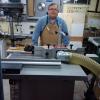We have an 8 inch jointer and just added the helical cutter head. I was watching my son run a 6 ft cherry board, 2 inches thick by approx 6 inches wide and he was really putting a lot of effort into each pass; looked and he was taking of roughly 1/16th with each pass. Got me wondering if we are doing something wrong with our technique or taking too much off at a pass, or something else. To give an idea, when we joint a roughly flat board, we can normally accomplish it in 3 - 4 passes.
Any thoughts would be appreciated




 Reply With Quote
Reply With Quote










